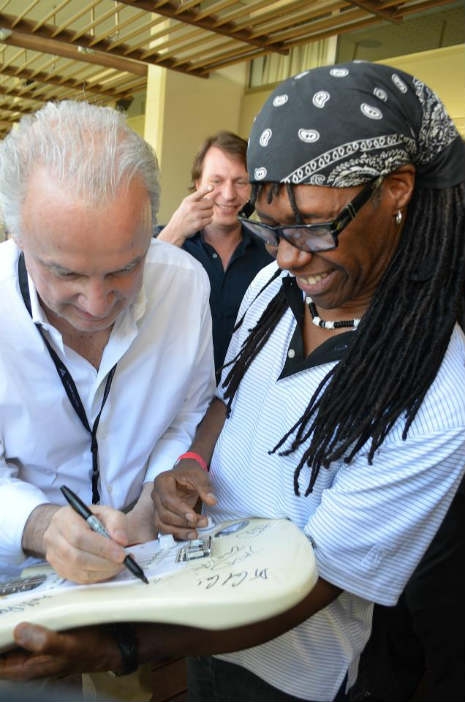
The masters meet. What a moment.
The guy in the background gets it.

The masters meet. What a moment.
The guy in the background gets it.
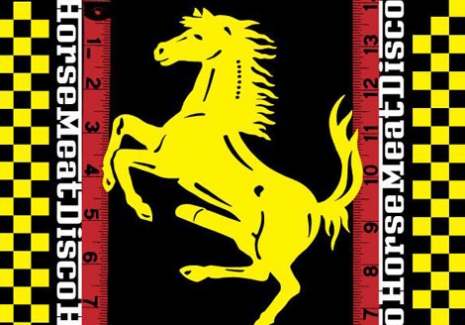
Horse Meat Disco are one of the most recognisable names in the modern dance music landscape, a four-piece dj unit known for their top quality record selection as well as their rather cheeky “boner horse” logo.
Focusing heavily on disco music, Horse Meat have done much to rehabilitate that maligned genre in the eyes and ears of the club-going public, and have already released three compilations of rare disco gems on the London-based funk and disco Strut label.
Their weekly party in South London’s Vauxhall is a free-for-all of dancefloor intensity and wickedly positive vibes. It’s overtly-gay, yet open-for-all, and its friendly atmosphere has done wonders to re-establish gay clubbing (and clubbing period) as something cool and fun to do in these down-at-heel times. By concentrating, heavily but not exclusively, on music from the 70s and 80s, Horse Meat have reconnected the modern gay audience with their own, often overlooked, history and culture, and serve as a timely reminder that going out, getting out of it and dancing ‘til the wee small hours was not invented yesterday.
In short, they’re legendary. And it’s my favorite club. To me, the best description of Horse Meat Disco comes from the Brixton DJ and label owner Andy Blake, who calls the club “roots music for the gay community.”
For their latest podcast, the second in a new series being made available through Soundcloud, Horse Meat Disco DJs James Hillard and Luke Howard have put together over an hour of their favorite tracks by Donna Summer, who died last week at the age of 63.
It’s a suitably joyous, and touching, celebration of disco’s reluctant female queen, and features much of her work with super-producers Giorgio Moroder and Quincy Jones, including a whole side of the excellent 1977 LP Once Upon A Time. Although generally regarded as a “singles” artist, Summer had some killer album tracks, as demonstrated here. She could also turn her hand to straight-up soul as opposed to icy electronica, and must rank as one of the most sampled artists of all time.
I wonder if any current musical “gay icons” will leave such a lasting legacy?
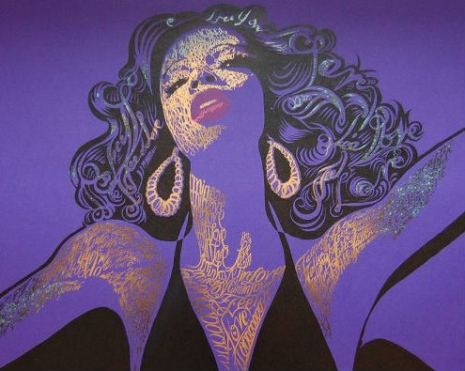
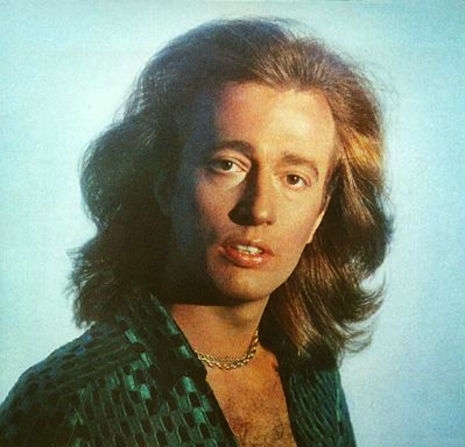
From one disco legend to another, Nile Rodgers has just posted this to his Facebook wall, saying:
“Our pre-CHIC tribute to the Bee Gees “You Should Be Dancing.” Robin Gibb RIP”
The Big Apple Band was indeed Rodgers’ pre-Chic project, and are not to be confused with composer Walter Murphy’s disco outfit of the same name. The sound of The Big Apple Band is rawer and grittier than either Chic or the Bee Gees (even though the Chic rhythm section of Rodgers on guitar, Bernard Edwards on bass and Tony Thompson on drums are all present and correct).
Rodgers says this of the Big Apple Band (who have another clip, this time performing Earth Wind And Fire’s “Get Away,” here):
It’s The Big Apple Band, which is us pre-CHIC playing live in a video recording studio. It was made by Kenny Lehman, the co-writer of CHIC’s debut single “Dance, Dance, Dance.” Kenny was also a booking agent who was trying to get us gigs doing high-school proms. We never got one prom gig but did lots of gigs on the chittlin’ circuit, and the seeds of CHIC were being planted.
In my memoir “Le Freak,” I tell how Bernard and I were developing into sophisto-funkers while others around us weren’t quite convinced. Notice that only he and I are wearing suits while our band mates are more Rock & Roll casual. The band was forced to change its name after composer/arranger/producer extraordinaire Walter Murphy, had major success with a great disco reworking of Beethoven’s Fifth Symphony. He called it “A Fifth of Beethoven” by Walter Murphy and the Big Apple Band.
It’s been a bad few weeks for fans of disco and soul, with the passing of Donna Summer, Donald Dunn and now Robin Gibb. Rodgers himself has been very ill recently with cancer (which he writes about movingly on his blog), so here’s hoping he’s not added to that list.
And here’s a great testament ot the songwriting genius of the brothers Gibb. Rest In Peace Robin:
The Big Apple Band “You Should Be Dancing”:
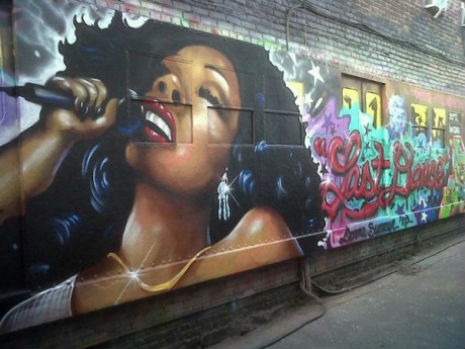
Via Ego Trip:
Moved by the news of Donna Summer’s death, South Bronx-bred aerosol artist and DJ, SERVE (a/k/a SERVE ONE), wasted no time painting the stunning mural pictured above in homage to the late singer. With “Last Dance” – the title of Summer’s 1978 classic – emblazoned by an iconic image from the cover of her Live & More LP of the same year, it’s a beautiful piece of work. “I just had to do it…” SERVE wrote on his Facebook wall to the enthusiastic response of friends. Props, SERVE. RIP, Donna Summer.
Beautiful.
Here’s another thing of rare beauty, Donna performing the wonderful “Spring Affair” from the Four Seasons Of Love EP on Soul Train:
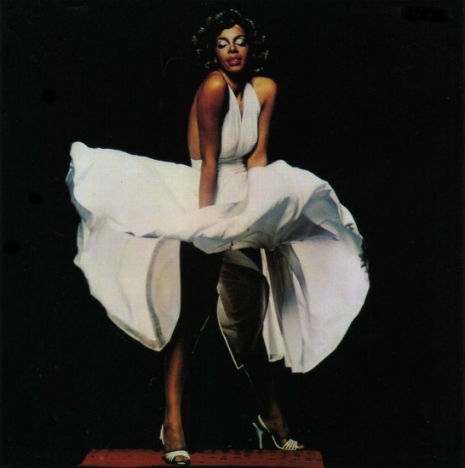
I’m feeling a little spooked out right now, not just at the news that the number one Disco Queen Donna Summer has died at age 63 after battling cancer, but also because I was going to post this clip today just because it is so damn good.
Taken from a 1979 TV special, here is Donna performing a live version of her classic “Sunset People” from the Bad Girls LP. The original track is one of my all time disco favorites, and one of her best collaborations with that damned pop music genius Giorgio Moroder.
In this clip Donna performs the track live while walking down the actual Sunset Strip, and play acts different roles of some of the Strip’s denziens (starlet, showgirl, traffic cop.) The track itself is different to the recorded version too, being slightly faster and sounding more “live band” than “studio whizz.”
The reason I wanted to post this clip today, before I heard the news, is that it is awesome, a real treat for Summer/Moroder/disco fans. Only now it takes on a new gravitas as the news filters through of Summer’s untimely death. And there I was, only recently pondering the thought of a Donna Summer-revival tour. She was one of the few major (still living) solo acts from the disco period not to be out touring again, and a glaring omission from the Etam Paris Fashion week “Disco Divas” show (which featured Grace Jones, Sister Sledge, the Pointer Sisters, Chaka Khan and Gloria Gaynor - what a fucking line-up!).
There are going to be plenty of Donna Summer obituaries coming through over the next few days with the passing of this true legend. If you’re aware of my other posts over the last 18 months here on Dangerous Minds, you will have gathered by now that I am a disco music obsessive. I shouldn’t have to explain what Donna Summer means to me, or to popular music culture in general. After the male-oriented “free love” boom of the 60s, she brought assertive female sexuality to the masses with “Love To Love You Baby” in 1975. Along with Giorgio Moroder, Summer redefined pop music with the epoch-defining “I Feel Love.” Hell, I still drop that track in my dj sets to this day, and it never fails to tear the roof off.
If you’re still in doubt as to how important her work was, ask Bernard Sumner of New Order who was more important to the band - Donna Summer or Kraftwerk?
Well then, here’s to you Donna Summer, performer and co-author of some of the best songs in dance, and pop, music history. You will be missed!
Donna Summer “Sunset People” (1979 TV special version)

More synthesizer-based disco lushness, this time with a punk/new-wave twist.
The Units were one of the first synth-punk bands to appear out of San Francisco in the late 70s and “High Pressure Days” is one of their best-known tracks. It’s a slice of neurotic punk-synth-funk that’s brimming with pent-up energy.
Todd Terje hails from Oslo in Norway, and is one of the most respected re-editters/remixers in nu-disco and house. His recent EP release It’s The Arps is definitely worth checking out.
When these two got together it was moidah. This remix of “High Pressure Days” has just been released on 12” by Opilec Music (with more remixes on the flip by I-Robot), and can also be found on the exhaustive Units’ remix album Connections:
Previously on Dangerous Minds:
Roxy Music “Love Is The Drug” (Todd Terje Remix)
Original Synthpunk pioneers The Untis present ‘Unit Training Films’
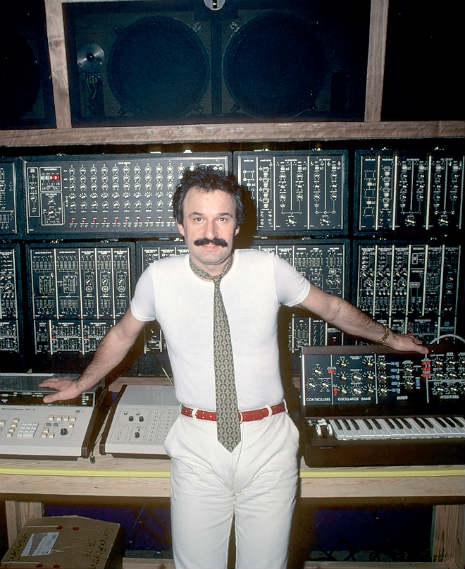
The Italian music maestro Giorgio Moroder turns 72 today.
In a career that spans well over forty years, Moroder has a strong claim to being one of the most influential producers ever. His ground-breaking work with Donna Summer brought electronic music to the masses with the smash “I Feel Love” in 1977, while the duo’s earlier collaboration on “Love To Love You Baby” set in stone the template for the extended, orgasmic disco mix.
Then there are his seminal pop productions for the likes of Blondie, David Bowie, Sparks and the Human League’s Phil Oakey, plus his revolutionary synthesiser scores for Scarface, American Gigolo and Midnight Express (which bagged Moroder an Oscar for Best Score in 1978.)
Often written out of “serious” musical history because of his poppy tendencies, Moroder’s incredible legacy speaks for itself and has defiantly stood the test of time.
Here’s one of my favourite Moroder tracks, the less well-known “Utopia, Me Giorgio” off the album Giorgio from 1977 (here given the extended re-edit treatment by Disco Beard.) 19freakin’77 - that means this track is now 35 years old, and I’ll be damned if it doesn’t sound as fresh now as it did back then:
Giorgio Moroder “Utopia, Me Giorgio (Disco Beard Anniversary Edit)”
Tip of the hat to World Of Wonder.

At the time of his death on April 4th 1992, Arthur Russell could barely get arrested. There’s a moving scene near the end of the Wild Combination documentary on his life, which was filmed at one of Russell’s last ever gigs before he passed away. It’s a beautiful performance made all the more moving by the short time he has left, but painfully sad as it is obvious from the weak cheers that not many people are there.
However, twenty years later things could not be more different. Today Arthur Russell is widely recognised as being one of the most important composers and performers of his generation, and one of the most influential artists of the past two decades. From house to hip-hop to folk, dub, ambient and jazz, there are not many acts about today who could claim not to have been touched by his skewed genius.
Buddhist, cellist, cruiser, prodigious pot smoker - Arthur Russell was a genuine outsider artist, but without the usual negative, cynical connotations that term brings to mind. He didn’t—couldn’t—play the industry game as his muse was too strong, and he was known to obsessively re-record his signature compositions and melodies, often in wildly different styles. His music was genuinely years ahead of the curve and accordingly it took the world a while to catch up to his unique talents.
Russell’s music touched on many genres, but he is still best known for his work in the field of disco (and later what would go on to be called “house”.) The man pretty much invented “alternative disco” (“post-disco” is perhaps a better phrase) and the Larry Levan remix of his Loose Joints track “Is It All Over My Face” is one of the most influential—and sampled—tracks of all time. If anyone one artist could be said to have given the maligned genre of disco some credibility and kudos, then it is Arthur Russell.
I vividly remember the first time I heard “Is It All Over My Face” and simply being blown away. After a couple of years of casually liking disco as a sunny, kitsch reaction to the overbearing, vapid gloom of 90s alternative rock and Britpop, I had started to pick up bits and bobs on vinyl to play around with on my newly-purchased turntables. The track was near the end of a disco compilation on Strut records called Jumpin’, that featured uptempo, funked-fuelled productions by the likes of Patrick Adams and August Darnell. Great tracks for sure but this was something else completely. It was breath-taking.
Here was a track as heavy and funky as anything by Daft Punk but whose bizarre vocal and chattering arrangement marked it as coming resolutely from the left field. It sounded like nothing else I had ever heard, yet felt like a record I had been waiting my whole life to hear. Instantly house music made a lot more sense, and disco became a real proposition, a serious genre that demanded more respect and closer inspection. To anyone who still insists on disco being plastic/shallow/conformist/blah blah blah, simply put this track on and warm yourselves up a nice big cup of STFU.
But there is a lot more to Arthur Russell than just four-to-the-floor avant funk. His music has a genuine other-worldiness that can only be a product of a singular imagination. Where his disco productions were propulsive and off-kilter, his folk and acoustic tracks have a delicate beauty to rival the tenderness of Nick Drake. The minimalist cello-and-vocal compositions on his World Of Echo album may have faint traces of Terry Riley and the Velvet Underground, but they still sound like nothing else. In a world where music seems to be going in ever more decreasing circles, and where careers are getting shorter and shorter, it’s not hard to see why Arthur Russell now commands such serious respect.
If you are new to the man and would like a crash course in his music, then the Soul Jazz compilation The World of Arthur Russell is the place to start, and once you are done there, move on the album re-issues on the Audika label. If you have the music but want to know more about the man himself, then Tim Lawrence’s biography Hold On to Your Dreams: Arthur Russell and the Downtown Music Scene, 1973- 92 is recommended, as is the previously mentioned documentary Wild Combination: A Portrait of Arthur Russell (whose trailer you can see here.)
But for now here are two of my favourite Arthur Russell songs. Two to show the many sides of this incredible talent—the first is a short ballad, the second a full-blown psychedelic epic—and two to mark the two decades since this extraordinary artist left our sphere:
Arthur Russell “A Little Lost” (fan video)
Arthur Russell “In The Light Of The Miracle”
Thanks to Kris Wasabi for the reminder!
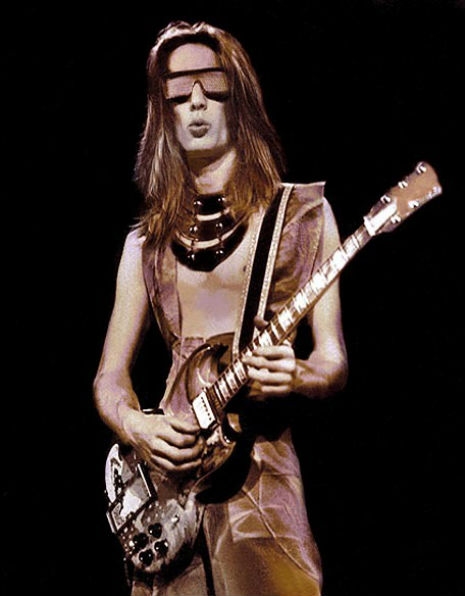
When the promo for the new single by Norwegian nu-disco maestro Lindstrom dropped into my inbox recently, I was unusually excited. Not just because it was some new sounds from one of the undisputed masters of the genre, but because of these three magic words: “Todd Rundgren Remix.”
At first I thought it was a typo, or a mislabeling - surely they meant it’s a Lindstrom remix of Todd Rundgren? I mean, you can tell Lindstrom is a fan just from listening to his music (it’s all about those stacked synth chords) and besides, Todd doesn’t do remixes… does he?
A little bit more digging around proved that this was no typing error. One of my all-time favorite artists had indeed remixed a song for the first time, and with his usual immaculate taste, Todd had decided to remix a song by one of my favorite dance music producers. Through connections in the extended Rundgren fan network (which is itself an amazing thing, more like a family than mere rock fans) I was able to get some questions to Todd himself.
Dangerous Minds really needs more Todd Rundgren on our pages, so I am glad to share his answers:
You’ve been making music for a long time, but this is your first ever commercially released remix - how did it come about?
I was contacted by Lindstrom’s label. I’ve been making contributions to other artists’ recording projects over the years so it didn’t seem like that unusual a request. I don’t often get asked to be involved in ‘trans-generational’ collaborations, so that was different.
Your music has been a big influence on modern dance producers, but in particular the whole nu-disco/cosmic-disco genre - were you aware of any of those particular artists? And did you hear a musical connection when you listened to Lindstrom’s track?
Since I don’t usually focus on a single genre I don’t think of myself as having a ‘style’. It’s a little odd because in the 70s we thought of ourselves as prog-rock players and that disco was something of a sell-out for artists like Rod Stewart and Blondie. This ‘nu disco’ is a more organic movement, especially the emphasis on the instrumental aspect and lack of lyrics. That does remind me of some of the experimental excursions I’ve taken in the past.
I love how you embrace new music technology (and the new music it can help create). I’m curious to know what sequencing/recording program you’re using, and if you have any recent-ish programs or bits of kit you’re enthusiastic about? For instance, have you used Ableton Live?
I stuck with analog until the mid-Nineties, mostly because I was trying to be thrifty. I used Pro-Tools for about 12 years but finally got fed up with the tempermental and expensive technology and poor support. Recently, I have been an exclusive user of Propellerheads Reason. Since they added recording capabilities I’ve been able to record and mix with my laptop and without any environmental restrictions. I haven’t tried Ableton, mostly because I have yet to do any live mixing.
What are you listening to at the moment? Any music of the last 5 years that floats your boat and you’d recommend for Dangerous Minds’ readers?
I’m a big fan of ‘outsider’ music. It’s not very useful as an influence (at least not right now) but it’s a lot of fun to listen to and takes your mind off the ‘serious’ stuff. I recently downloaded Lorne Greene’s “The Man” and was so amused I decided to work some of it into my solo shows. Now the fans want a whole night of Lorne Greene. The problem with outsider music is that it’s often only one great song in an obscure career of mediocrity.
What’s in the immediate future for Todd Rundgren?* And is there anything more dance music-based, like more remixes or perhaps even dj sets?
It’s been suggested that I take a crack at DJing, and it’s not such a far-fetched idea. In 1993 I toured a record called No World Order and built a system that allowed me to improvise the set each night using a midi controller and a program I devised that would recombine samples on the fly. I had to build that program from scratch using MAX. Now software like Ableton is the prefered way to go, although I have some ideas about how it could be done with Reason.
Thanks, Todd!
Lindstrom’s “Quiet Place To Live (Todd Rundgren Remix)”, released by Smalltown Supersound, is available to buy from Juno Download. You can listen to it right now:
Lindstrom - Quiet Place To Live (Todd Rundgren remix) by smalltownsupersound
And thanks to Jill Mingo!
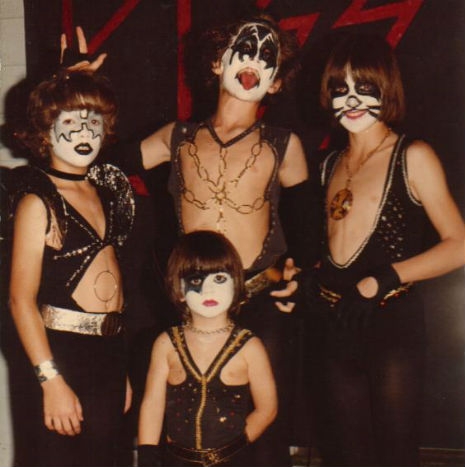
OK, enough of the hating between the rockers and the disco-freaks! This ain’t the damn 70s, so why can’t we all just get along? In love, peace and some sweat-drenched bell bottoms? Besides, there is a big crossover between these two supposedly “opposing” genres.
About five or six years ago, at the height of both nu-disco and the Italo revival (and while I was releasing music under the name Trippy Disco), I found myself playing more and more vintage disco records with crashing power-chords and wailing axe solos. Because of the “sell out” accusations that these kind of records attracted at the time (from both camps) it’s a side of disco that’s been neglected, even though I love those sounds. So, I decided to put together an hour’s worth of my favourite disco/rock records, and, lo, the ‘Skool Of Rock’ mix was born.
I decided not to feature anything too “New Wave” or post-punk as the disco influence on those sounds was already very obvious, though I did get to slip in a few acts who would technically be classed as “disco” but who dipped into “rock” now and again (Edwin Starr and Giorgio Moroder, for instance.) And accordingly, there’s also the obligatory disco cash-ins by some of your favourite rock acts (Queen, Bowie, ZZ Top.) Besides that, there are some real gems here, including the Patrick Cowley remix of Tantra’s “Hills Of Katmandu” which is one the most “fuck yeah!” fist-pumping disco anthems of all time.
So, you might love this mix, you might really hate it, but either way here it is:
Tracklist:
ELO “Don’t Bring Me Down (Trippy Disco Re-Edit)”
CREEDENCE CLEARWATER REVIVAL “Fortunate Son”
ROCKETS “On The Road Again”
EDWIN STARR “The Rock”
CHILLY “For Your Love”
KISS “I Was Made For Lovin’ You”
TANTRA “Hills Of Katmandu (Patrick Cowley Megamix / Automan Edit)”
LED ZEPPELIN “Whole Lotta Love (Acapella)”
MATERIAL “Bustin’ Out”
ZZ TOP “Legs (Metal Mix)”
GIORGIO MORODER “Evolution”
MACHO “Not Tonight (Dimitri From Paris Re-Edit)”
SKATT BROS “Walk The Night (Album Version)”
QUEEN “Another One Bites The Dust”
DAVID BOWIE “Stay”
WINGS “Goodnight Tonight (Trippy Disco Re-Edit)”
You can download the ‘Skool Of Rock’ mix here.
BONUS!
David Bowie performing “Stay”, live on Muzikladen, Bremen 1978:
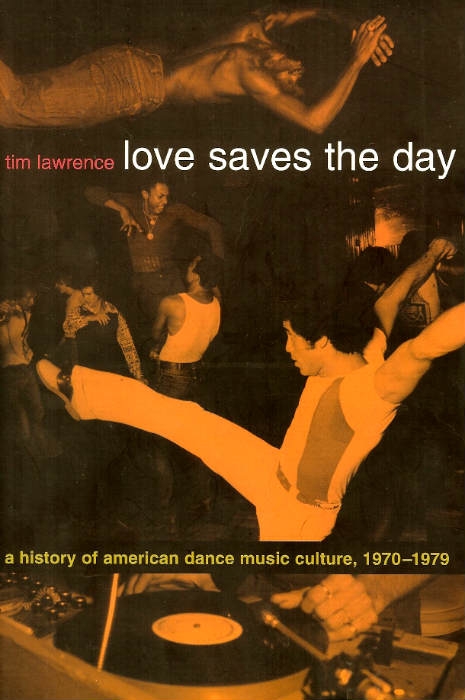
Many, many books have been written about disco, and I have read a whole bunch of them (including more well known works like Turn The Beat Around: The Secret History of Disco by Peter Shapiro, Everybody Dance: Chic and the Politics of Disco by Daryl Easlea and The Last Party: Studio 54, Disco and the Culture of the Night by Anthony Haden Guest) but still nothing comes close to matching Tim Lawrence’s exhaustive yet entertaining Love Saves The Day: A History of American Dance Music Culture 1970-79.
For those of you who still believe that disco was nothing more than an music-industry creation dreamt up in a backroom by a bunch of coked-up suits and sold to passive, gullible consumers too high to know it was an empty fad (here’s looking’ at you, Em!) then you need to get your hands on this book. That goes for anyone else with an interest in the disco genre, particularly those who know the basics of the story but crave more. Because, believe me, it’s all here.
Lawrence is a lecturer at the University of East London and a renowned writer on dance music and culture. He has in the past published books on the avant garde/disco composer and performer Arthur Russell (Hold On To Your Dreams; Arthur Russell and the Downtown Music Scene 1973-1992) and most recently added the introductory foreword to Voguing And The House Ballroom Scene of New York City, 1989-92. But to me, at least, Love Saves The Day is still his best work. From his website:
Opening with David Mancuso’s seminal “Love Saves the Day” Valentine’s party, Tim Lawrence tells the definitive story of American dance music culture in the 1970s - from its subterranean roots in NoHo and Hell’s Kitchen to its gaudy blossoming in midtown Manhattan to its wildfire transmission through America’s suburbs and urban hotspots such as Chicago, Boston, San Francisco, Los Angeles, Newark, and Miami.
Tales of nocturnal journeys, radical music making, and polymorphous sexuality flow through the arteries of Love Saves the Day like hot liquid vinyl. They are interspersed with a detailed examination of the era’s most powerful DJs, the venues in which they played, and the records they loved to spin - as well as the labels, musicians, vocalists, producers, remixers, party promoters, journalists, and dance crowds that fuelled dance music’s tireless engine.
TIm Lawrence may not have lived through this era, but his book is phenomenally well-researched and features interviews with all of the remaining key players, sketching the very earliest days of the movement: from David Mancuso’s Loft parties to Francis Grasso mixing records at the Sanctuary as far back as 1970 (the first dj ever to do so), from Nicky Siano opening The Gallery while still a teenager in 1972 to Steve Ostrow’s gay/mixed Continental Baths (home not just to performances by Bette Midler and Barry Manilow, but also the venue where future legendary djs Larry Levan and Frankie Knuckles cut their teeth.) all the way up through the decade to the opening of both Studio 54 and the Paradise Garage.
Love Saves The Day IS exhaustive (perhaps too exhaustive for disco newcomers) and while it can act as a great reference for fact-checkers, it’s also an entertaining read that spares little detail of the complicated drug-and-sex lives of these people. This was an era of radical social change and these folks (and this music) were right at the forefront of those changes. The first chapter of Love Saves The Day is available to read in full on Lawrence’s website, and it focuses on David Mancuso, the man whose Loft apartment-cum-dance-space gave birth to disco culture and who, to this day, remains the beating heart of “real” disco. It also makes clear the connection between hippie culture of the 60s and the emerging gay/black/female-centeric dance culture of the 70s:
When it came to public venues Mancuso’s preferred to go to the Electric Circus, which opened in June 1967, and the Fillmore East, which opened in the spring of 1968. Both of these psychedelic haunts were situated in the East Village — the Electric Circus was located in an old Polish workingman’s club on St. Mark’s Place, the Fillmore East, in the words of the New York Times, on “freaky Second Avenue” — and both hosted live entertainment 1. “I went to the Electric Circus at least once a month,” says Mancuso. “Everybody was having fun and they had good sound in there. It was very mixed, very integrated, very intense, very free, very positive.” The Fillmore East showcased some of his favourite artists. “I heard Nina Simone perform there. I went with my friend Larry Patterson. The Fillmore East would often be noisy but that night everybody was very focused. She was wonderful.”
Mancuso didn’t just go to the Fillmore East to listen to music. “That’s where I also first heard Timothy Leary. He gave a series of lectures backed by the Joshua Light Show.” The ex-Harvard academic was already an important figure for Mancuso, who had first taken Sandoz when he was twenty and the drug was still legal. An early trip coincided with a snowstorm (“each flake was like a universe”) and ten tabs later he came across Leary’s The Psychedelic Experience Based on the Tibetan Book of the Dead, which argues that psychedelics can provide a shortcut to enlightenment. “The book blew me away. It became my bible and I started getting involved with him.” The young acolyte met the acid guru at his LSD (“League for Spiritual Discovery”) headquarters in the West Village, went to his Technicolor lectures and became a regular at his private parties. “People were tripping but the parties were more social than serious. There was food and music. I knew we were on a journey.”
Mancuso’s personal voyage took a vital turn in 1965 when he purchased the key to 647 Broadway, just north of Houston, for two hundred dollars.Like Soho, NoHo (as the north of Houston area was nicknamed) had historically functioned as a manufacturing district, drawing on New York’s immigrant population as its low-wage workforce, and when industry relocated to the cheaper terrain of New Jersey and beyond New York’s artists moved in, delighted to exchange their cramped Upper East Side apartments for a range of stunningly expansive lofts. The influx triggered off a sophisticated experiment into the relationship between art, space and living that apparently excluded the likes of Utica-born Mancuso, but he quickly established himself as a key player within this creative population, intent as he was on reintroducing art back into the party. “Everyone loved my space,” he says. “There might have been a hundred people living like this so it was very new. A lot of people would just come and hang out there. There were all sorts of activities going on.”
Some of these activities were influenced by Leary. “I would organise these intimate gatherings where we would experiment with acid,” says Mancuso. “There were never more than five of us when we did this. One person would take nothing, another would take half a tab and the rest would take a whole tab. It was all very new and we took it very seriously. We used The Psychedelic Experience as our guide.” Leary also had a bearing on the decoration of the loft space. “I built a yoga shrine, which I used for yoga and tripping. In the beginning it was three feet by five feet and it eventually grew to fifteen feet by thirty feet. As you walked into the loft you were immediately drawn to this area. It was gorgeous.”
Music — which was similar to LSD inasmuch as it could function as a therapeutic potion that “de-programmes” the mind before opening up a mystical trail that culminates in spiritual transcendence — was also introduced into the equation. “Leary played music at his lectures and parties and I went in the same direction. I bought a Tandberg tape recorder so that I could play tapes. The Buddha was always positioned between my two speakers.” That was the perfect position from which to hear the homemade compilations, which drew on a diverse range of sources and were structured to complement the hallucinogenic experience. “I made these journey tapes that would last for five hours. They drew on everything from classical music to the moody blues. They would start off very peacefully and the reentry would be more about movement, more jazz-oriented. Somebody might get up and start dancing around the room at some point, although they weren’t dance sessions.”
...and that’s just the tip of the iceberg!
I can’t stress enough how good this book is, and how anyone with an interest in disco, underground culture or the 70s should try and track down a copy. It features some invaluable dj playlists from specific spots and times, which act as a checklist for a whole world of great, under-valued music, but besides that, it’s just a great read. I dip in and out of it all the time, and still find amazement and amusement after many readings, so I guess it would be pretty fair to say that Love Saves The Day is my bible.
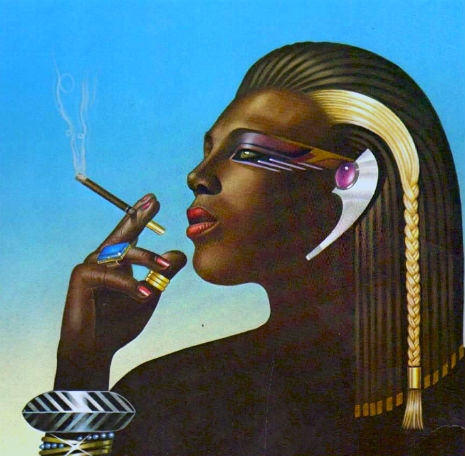
If there’s any one artist who represents everything that was revolutionary about disco music, it was Sylvester. It doesn’t matter how many Bee Gees, Ethel Mermans, Rod Stewarts, Boney Ms et al you can throw at the genre as a reason to hate it, the fact is that if it wasn’t for disco there is no way that a linebacker-sized, black, openly gay, outrageous, gender-bending performer like him could have reached the top of the world’s charts.
Sylvester broke every taboo going. In fact he didn’t just break them: he tore them up, threw them on the floor and stamped on them with uproarious glee, all while dragging you out to dance with his irresistable energy. He didn’t have to shout about any of his social or political inclinations because he was already living them, out in the open, for everyone to see.
Sylvester didn’t make “political music” because he didn’t have to: Sylvester’s very existence was inherently political.
That to me is the rub when it comes down to “disco” versus “punk”, and all that bullshit snobbery and scorn rock fans heaped on disco. Contrast Sylvester with any one of the gangs of middle class, straight, angry-at-whatever white boys that were supposedly turning the world upside down in the name of “punk” and it becomes clear who was really pushing social boundaries.
The fact that the music was instantaneous and accessible only deepens the subversive effect. It’s unfortunate that “disco” has become an easy way to dismiss that which genuinely does not fit the rock cannon’s hardened mould, be it for reasons of race, gender or sexuality, but the music itself never died away. It reverberates still with an incredible, universal power. Sylvester was a supremely talented vocalist and performer, and I just couldn’t take seriously any music aficionado who claimed not to be moved by “(You Make Me Feel) Mighty Real” (not to mention “I Who Have Nothing,” “I Need You,” “Do You Wanna Funk,” “I Need Somebody To Love Tonight,” etc, etc.)
And besides, if I had a choice between a bunch of white punk boys or black drag queens, I know who I’d rather party with.
Unsung is a series produced by TV One profiling some of the more over-looked, yet supremely talented, names in black music from the 70s and 80s. There’s much to enjoy here if soul, funk and R&B are your thing. Other artists covered include Teddy Pendergrass, Zapp, Rose Royce, the Spinners and many more.
But for now let’s just enjoy the uplifting, touching and ultimately tragic story of the real queen of disco music:
Thanks to Paul Gallagher!

... as in The Joy Of Sex.
A special treat this Sunday for all our disco-fan readers outside the UK, The Joy Of Disco is a BBC documentary about that much derided music genre that seemed to come out of nowhere to change the world in the late 70s.
I’ve seen a lot of documentaries about disco, and this is undoubtedly one of the best. Featuring new interviews with many of the key players (Giorgio Moroder, Nile Rodgers, Nona Hendryx, David Mancuso, Tom Moulton, Kathy Sledge, Nicky Siano and lots more) and some great, rare footage of top nitespots like The Gallery and Studio 54, this is a real treat for the disco fanatic.
But what really makes The Joy Of Disco so good (and well worth a watch, even if you are not a disco fan) is the placing of the music in its proper historical and social context. Disco was black, urban music that became the soundtrack to the gay liberation movement and, according to the program makers:
foregrounded female desire in the age of feminism and led to the birth of modern club culture as we know it today, before taking the world by storm.
All up to the (seemingly inevitable) racist and homophobic “Disco Sucks” backlash. That put paid to the faddishness of the genre, but ultimately, by driving it back underground to the gay and black clubs that spawned it, helped make it stronger than ever and actually did very little to kill the sheer joy of the music itself.
The Joy Of Disco explores these issues in the kind of detail they deserve. It aired on BBC4 on Friday night, and some industrious soul has already put it up on YouTube to share the love (yes, it’s another case of get it before it’s gone). This is highly recommended viewing - you won’t see anything this interesting, exciting or fabulously funky on your screens this evening:
The Joy of Disco, part one:
The Joy Of Disco parts 2 to 4 after the jump…
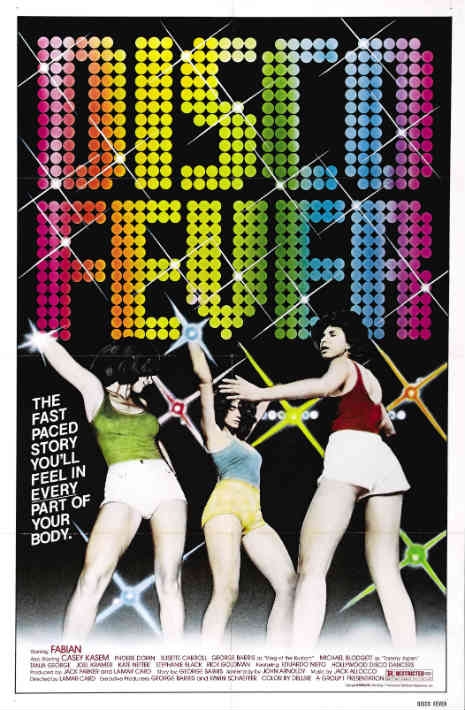
While looking up a suitable image for last night’s post on disco by Simon Frith, I came across a film called Disco Fever, a disco-exploitation oddity from the same year as the article, 1978.
As a fan of both disco music and cult cinema I was surprised to never have heard of this, and now I’m wondering if any of our readers have seen it? In case your memory needs jogging, it stars Casey Kasem and some dude called Fabian, and a lot of the action seems to revolve around a discotheque which is onboard a jumbo jet. Here’s the original trailer for further investigation (this film may just be so bad it’s good, or it may just be so bad):

From the Daily Mirror newspaper, 1978 (uploaded by Cornershop15)
This 1978 essay on the cultural meaning of disco by the respected British musicologist Simon Frith (author of Performing Rites: On the Value of Popular Music and Sound Effects: Youth, Leisure and the Politics of Rock ‘n’ Roll) was recently unearthed and re-published by the ever excellent DJHistory.com.
It goes some way towards highlighting the difference in appreciation of the genre on both sides of the Atlantic—it always seemed to me that disco never had the cultural impact in the UK that it had in the States, possibly because of the distinct ethnic and social heritage of the music—while Britain had to wait another ten years to experience its own genuine dance revolution.
What is common on both sides of the Atlantic, and of interest to anyone who likes disco music or lived through these years, was the sneering derision the genre faced from rock listeners and their corresponding press. It took another 20 to 30 years to rehabilitate disco’s reputation, and it’s interesting to read these very criticisms usually levelled by the music media coming from a self-professed disco fan:
In public I’m into punk like everybody else (saviour of rock ‘n’ roll’s soul and all that) but privately I’m a junk rock junkie and the junkiest music of all is disco. Everybody hates it. Hippies hate it, progressives hate it, punks hate it, teds hate it, NME hates it, even Derek Jewell hates it.
Disco is music for the disillusioned. It isn’t art: no auteurs in disco, just calculated dessicating machines. It isn’t folk: no disco subcultures, no disco kids seething with symbolic expression It isn’t even much fun: no jokes, no irony, only a hard rhythmed purposefulness. Disco is the sound of consumption. It exists only in its dancing function: when the music stops all that’s left is a pool of sweat on the floor. And disco’s power is the power of consumption. The critics are right: disco is dehumanising – all those twitching limbs, glazed-eyed, mindless. The disco aesthetic excludes feeling, it offers a glimpse of a harsh sci-fi future. ‘What’s your name, what’s your number?’ sings Andrea True in my current favourite single, and it’s not his telephone number she wants, but his position in the disco order of things. The problem of pogoing, I’ve found, is not that it’s too energetic for anyone over 30 years and 11 stone, but that it requires too much thought.
Popular music has always been dance music; disco is nothing but dance music. It has no rock’n’roll connotations; off the dance floor it is utterly meaningless, lyrically, musically and aesthetically. Every disco sound is subordinate to its physical function; disco progress is technological progress. The end doesn’t change but the means to that end, the ultimate beat, are refined and improved – hence drum machines, synthesisers, 12” pressings. And disco is dance music in the abstract, content determined by form. Popular dance music of the past, in the 1930s say, was a form determined by its content. The content was developed by dance hall instructors and sheet music salesmen and band leaders whose rules of partnership, decorum, uplift and grace, can still be followed in ‘Come Dancing’: the music is strictly subordinate to the conventions of flounce and simper. In contrast, when Boney M, German manufactured black American androgynes, sing for our dancing pleasure, ‘Belfast’, it means nothing at all. Any two syllables arranged and sounding just so would do and how we dance to them is, of course, entirely our own affair. There are no rules in disco, it’s just that individual expression means nothing when there’s nothing individual to express. I trace disco back to the twist, the first dance gimmick to be taken seriously and the first dance step to be without any redeeming social feature. I blame disco on Motown, the first company to realise that if the beat is right, soul power can be expressed without either the passion or emotion that made it soul power in the first place.
You can read the rest of the essay here. In the meantime, here’s something by Andrea True Connection. It’s not “What’s Your Name What’s Your Number?” as mentioned in the essay itself, as I’ve never been a big fan of that track. Instead it’s an earlier gem by the band that predates the awfully similar sounding “Is It Love You’re After” by Rose Royce by a good three years:
Andrea True Connection “Call Me” (1976)